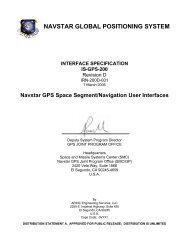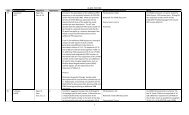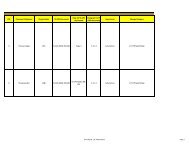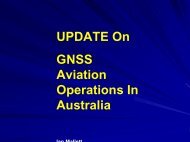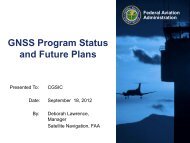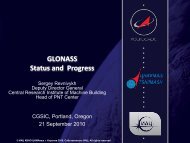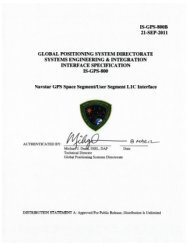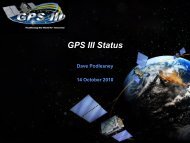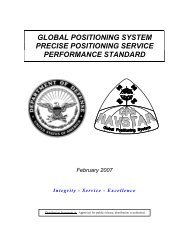GPS Status and Modernization - GPS.gov
GPS Status and Modernization - GPS.gov
GPS Status and Modernization - GPS.gov
- No tags were found...
You also want an ePaper? Increase the reach of your titles
YUMPU automatically turns print PDFs into web optimized ePapers that Google loves.
<strong>GPS</strong> <strong>Status</strong> <strong>and</strong> <strong>Modernization</strong>Munich Satellite Navigation SummitMunich, Germany10 March 2010Lt Col Elizabeth RoperDeputy Chief, PNT Requirements DivisionAir Force Space Comm<strong>and</strong>"DISTRIBUTION A: Approved for publicrelease; distribution unlimited""This briefing is for information only. No US Government commitment tosell, loan, lease, co-develop or co-produce defense articles or providedefense services is implied or intended."
Overview• <strong>GPS</strong> Overview• Recent Events• <strong>Modernization</strong> Improvements2
Critical Asset• Vital to International Security, Economic Growth, <strong>and</strong> Public Safety• Extends across all domains -- air, l<strong>and</strong>, sea, space, cyberspace• Effects transcend national <strong>and</strong> military boundariesAvailable, reliable, accurate, <strong>and</strong> free of charge3
<strong>GPS</strong> – Serving the World• Very robust constellation• 31 satellites currently in operation• 11 <strong>GPS</strong> IIA• 12 <strong>GPS</strong> IIR• 7 <strong>GPS</strong> IIR-M• 4 additional satellites in residual status• 1 additional IIR-M waiting to be set healthy• Global <strong>GPS</strong> civil service performancecommitment met continuouslysince December 1993• Next Launch – IIF-1, May 20104
<strong>GPS</strong> Control Segment• Operated by Space Professionals in 2d SpaceOperations Squadron at Shi Schriever AFB, CO• Backup facility at V<strong>and</strong>enberg AFB, CA• Global monitoring <strong>and</strong> antenna networksAlaskaaSchriever AFBEngl<strong>and</strong>V<strong>and</strong>enbergAFBHawaiiUSNO Wash, DCCape CanaveralBahrainSouth KoreaTahitiEcuadorAscensionDiego GarciaKwajaleinArgentinaSouth AfricaAustraliaNew Zeal<strong>and</strong>5
SPS Signal in Space PerformanceN/A N/A N/A N/A N/AtersRMSSignal-in-Spac ce User Range Error (URE), met2008 SPS Performance St<strong>and</strong>ard(RMS over all SPS SIS URE)Selective AvailabilitySystem accuracy exceeds published st<strong>and</strong>ard6
1995<strong>GPS</strong> IIA<strong>GPS</strong> <strong>Modernization</strong> –Space <strong>and</strong> Control Segments2005<strong>GPS</strong> II R / IIR-M2010<strong>GPS</strong> IIF2014 - 2025<strong>GPS</strong> IIISpaceSegment• St<strong>and</strong>ard Service• Single frequency(L1)• Coarseacquisition codenavigation• Precise Service• Y-Code (L1Y &L2Y)• IIA/IIRcapabilities plus• 2nd civil signal(L2C)• M-Code (L1M &L2M)• IIR-M capabilityplus• Backward compatible• 3rd civil signal • 4th civil signal (L1C)(L5)• Increased accuracy• 12 year designlife• Increased integrityControl SegmentLegacyControlSystemArchitectureEvolution Plan(AEP)Next GenerationControl Segment(OCX)7
<strong>GPS</strong> <strong>Modernization</strong> – Ground• Architecture Evolution Plan (AEP)• Transitioned in 2007• Modern distributed system replaced 1970’s mainframes• Increased capacity for monitoring of <strong>GPS</strong> signals• Increased worldwide comm<strong>and</strong>ing capability• Next Generation Control Segment (OCX)• Controls more capable <strong>GPS</strong> constellation• Monitors all <strong>GPS</strong> signals• $1.5B contract awarded 25 February 20108
<strong>GPS</strong> <strong>Modernization</strong> – New Civil Signals• Second civil signal “L2C”• Designed to meet commercial needs• Higher accuracy through ionospheric correction• 1 st launch: Sep 2005 (<strong>GPS</strong> IIR-M); 24 satellites: ~2016• Third civil signal “L5”• Designed to meet dem<strong>and</strong>ing requirements for transportation safety-of-life• 1 st launch: ~ 2010 (<strong>GPS</strong> IIF); 24 satellites: ~2018• Fourth civil signal “L1C”• Designed with international partners for GNSS interoperability• Begins with <strong>GPS</strong> Block III• 1 st launch: ~2014; 24 satellites: ~20219
<strong>GPS</strong> Exp<strong>and</strong>able• Optimize <strong>GPS</strong> assets to improve operational effectiveness for globalusers & terrain challenged environments• Increase the number of vehicles over head for betteravailability/coverage• Constellation expansion feasible with robust number of satellitesnow on-orbit• Consistent with the current St<strong>and</strong>ard Positioning Service (SPS)Performance St<strong>and</strong>ard• Adjust position of satellites in 3 of 6 orbital planes to createexp<strong>and</strong>ed constellation• Exp<strong>and</strong>ed constellation provides better GLOBAL coverage10
Summary• Largest constellation in history with best accuracy ever• Modernized d Comm<strong>and</strong> <strong>and</strong> Control System allows more signalmonitoring <strong>and</strong> quicker satellite comm<strong>and</strong>ing than ever before• Constant improvements through constellation management• And we’re continuing to modernize <strong>and</strong> improve <strong>GPS</strong> even more!<strong>GPS</strong> -- Serving the World11
<strong>GPS</strong> <strong>Status</strong> <strong>and</strong> <strong>Modernization</strong>Munich Satellite Navigation SummitMunich, Germany10 March 2010Lt Col Elizabeth RoperLt Col Elizabeth RoperDeputy Chief, PNT Requirements DivisionAir Force Space Comm<strong>and</strong>



